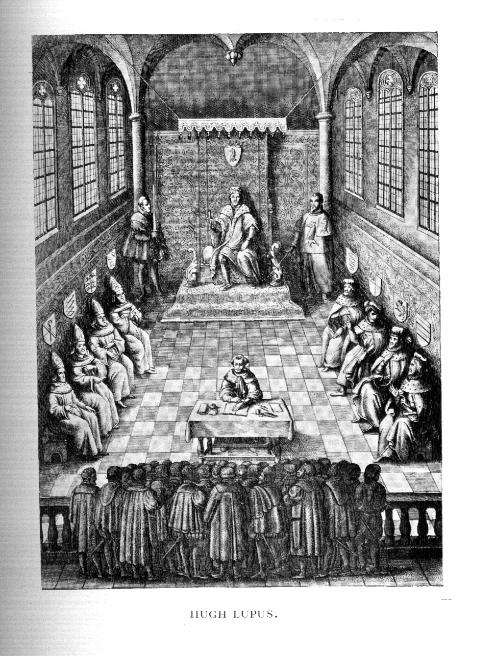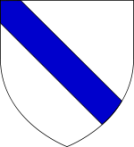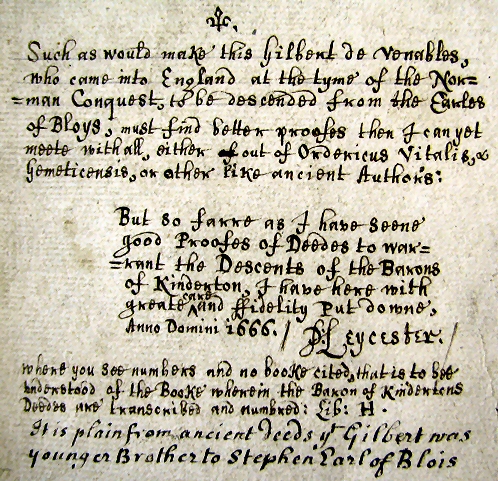From Ormerod’s History of Cheshire: Engraving showing Hugh Lupus holding court in 1109. The armorial bearings displayed identify the participants. Above Hugh is his arms, a wolf’s head. To his right are the representatives of the Diocese of Chester, Abbey Vale (three lions) Abbey of Norton, Abbey of Combermere. On Hugh’s left are his barons: Nearest the Earl is Nigell, Baron of Halton, Constable, and Marshall. Next is Massey, Baron of Dunham. Then, there is de Monhalt, Baron of Hawarden, steward. The last is Gilbert Venables, Baron of Kinderton.
Cheshire was a palatine controlled by the Bishop of Chester, the monks of St. Wereburg’s Church and Earl Hugh Lupus (the Wolf) of Chester. Hugh was 19 years of age at the time of the Norman conquest of England by William the Conqueror. He was the son of Richard d’Avranches, who fought at the pivotal battle of Hastings. As a palatine Count, he ruled Chester with impunity. He was a relative of William the Conqueror and one of the largest landholders in England. In Cheshire he held: Adlington, Alsager, Antrobus, Capesthorne, Chelford, Chester, Clive, Coddington, Eastham, Eaton, Eddisbury, Elton, Frodsham, Gawsworth, Helsby, Hawarden, Henbury, Hollingworth, Lea Newbold, Little Budworth, Lower Withington, Manley, Marton, Micle Trafford, Middlewich, Northwich, Occleston, Ollerton, Over, Romilley, Tintwistle, Weaver, Weaverham, Werneth, and Wimboldsley and Macclesfield. He also held: North Wales at Bodeugan, Calcot, Cwbyr, Fulbrook, and Maen Efa, and Hawarden.
William the Conqueror had made Cheshire the center of his northwestern defense against the Welsh and Irish. In 1070 he had wasted a large part of the county in retaliation against rebellious barons. The result was the destruction of villages, manors, the displacement of the population, and the collapse of the economic structure.
Into this wasteland came loyal Normans who had accompanied William and Hugh at Hastings and afterwards. Kinderton manor was ½ mile east of Middlewich.
From Vol. IV, Publications of the Huguenot Society of America, pp. 64-65; and William and Mary College Quarterly, Vol. XV, pp. 21-24:I.
From Venables, near Evreux, Normandy, Walter de Veneur was in 960, at the battle of the Fords, between Lothaire, King of France, and the Normans, where it is related that he was rescued by Duke Richard I., who, seeing de Veneur unseated, gave him his own horse (Palgrave, Hist. Normandy, ii., 738). The arms this family from Venables bore was or, or argent, a bend azure (La Roque, Hist. Harcourt, ii. 1181).
The ancient Castle of Kinderton was located along the Dane, two fields’ breadth from the old Roman works of Condate-a part of the moat is all that is left of it. The Castle has been taken down as well as the later Kinderton Hall. Kinderton Lodge is in another part of the Manor.
Of his ancestry, Sir Peter Leycester wrote:
… This Gilbert de Venables who came to England at the time of the Norman Conquest …it is plain from ancient deeds …was younger brother to Stephen, Earl of Blois.
Battle of Hastings 1066, Bayeux Tapestry
The next was Gylbert Venables,
The baron made of Kinderton,
From whoome the same to these our dayes
In downe-right Line did still hold on
To Peeter, who now holds the same,
Eniouing title, Lands & name,
Few howses shall you find beside,
That in one name soe long abide.
By Richard or Laurence Bostock
The First Three Barons of Kinderton
Gislebertus (Gilbert) de Venables came to England with William the Conqueror in 1066, and is found in the Battle Abbey Roll. Early documents also referred to Gilbert as de Venator, the Latin reference to his home village and family location. The venabulum a spear used for hunting boor is the name source for the Veneurs, who were the hereditary huntsman of the Norman Dukes. It is stated that the name was first, Gilbert vanator abilis meaning able hunter. The village of Venables is 30 miles past Rouen, in France, on the way to Paris. It is on a strip of land that is created by a loop in the river Seine. Nearby is the Chateau Gaillard, built by Richard the Lion Heart to defend that area of Normandy and the forest of Andeli.
Gilbert de Venables was given large tracts of land by the Conqueror primarily in Cheshire which he held under the Earldom of Cheshire, under Hugh Lupus. He held land in Eccleston, Alpraham, Wetnall, Hartford, one half of Limme, Tarporley, and High Legh. He also held Wincham Mere, Nether Peover, Hope, Newbold, Astbury, Brereton, Kinderton, Daneport, Witton, and Blakehall. It is said that he held 18 manors and 30 hides (100 acres is a hide.) He was given the title Baron of Kinderton, and was one of many lesser barons. Six of the manors that he held lay close together in Bucklow Hundred and in Middlewich Hundred. The Venables held their estates for about 700 years, until the death of Baron Sir Peter Venables, who passed the title and arms to George Vernon, creating Venables-Vernon, or Lord Vernon. The name Venables was carried on by the sons of younger sons born over that 700 year period, primarily descendants of the Venables of Agden and Antrobus.
Gilbert de Venables was noted in the records in 1086 and 1098. It is not clear what coat of arms Gilbert carried, however his seal was a falcon sinister regardant (falcon with his head looking backward, to the left of the shield bearer). He gave the advowson of the Church of Astbury to the Abbey of St. Werburge at Chester in 1098. His son is unknown, but in 1102 at Shrewsbury is Ulger Grosvenor, alias Ulger de Venables, with Roger de Nevil, and others. (The History and Antiquities of Shrewsbury: Vol. 1; Phillips) Gilbert de Venables’ grandson was Gilbert de Venables, Baron of Kinderton in the reign of Henry II.
This grandson, Gilbert, married Margery the daughter of Walthew, son of Wolfric, Lord of Hatton by whom he had halfe of Moxton near Gawesworth in ffrank-marriage.
According to Ormerod, Gilbert Venables … was the progenitor of numerous lines of the Venables family, of the Leghs of Booth, with their collateral branches, and the Meres of Mere; to which must be added with probability only not amounting to positive proof, the Leghs of West Hall, and with weaker, but still very strong probability, the Dones (Donnes), Leghs of East Hall, and Breretons. Also of this line were the Grosvenors, from gros venor (large hunter), and it would appear the Butlers of Chester, Barons of Warrington, who bore, or, a bend azure, differenced by the wheat sheaves of Chester.
Gilbert was the father of: William de Venables, Hamon de Legh, Gilbert de Lymme, Michael de Merston, Richard de Neubold, Hugh de Venables, Maud and Amabile. The third baron, died in 1188.
…Younger branches of the family of Venables, Baron of Kinderton, settled in various parts of the county (Cheshire); all of which (except that which took the name of Legh) are believed to be extinct: the families of Venables of Rothorne (Rosethorne), Newbold, and Elleston were extinct at an early period, that of Newbold continued from the reign of Henry III (1216) to that of Edward III (1327). Venables of Bradwall became extinct in the fourteenth century, when a co-heiress brought Bradwall to the Beringtons; the co-heiresses of Venables of Bollin, about the same period, married Booth and Trafford; a younger branch of Venables of Bollin settled at Antrobus, and afterwards at Wincham, and became extinct in the male line in 1687; …the family of Venables of Agden, an elder branch of which had been settled at Horton near Northwich, became extinct in the male line in the early part of the 18th century, and the family of Venables of Chester became extinct about the year 1700. … Robert Venables, a younger brother of George Venables… was the last male of the Agden branch (died 1759); A younger branch of the Agden family removed into Staffordshire in the sixteenth century. (Magna Britannia by Daniel Lysons, p. 393)
I would add here a clarification of what Lysons means by extinct. He means that the hereditary line ended without male heirs and the family’s hereditary property passed to descendants of daughters who did not carry the Venables name.




I’m researching my nephew & niece’s family for them (Grosvenor). I know they are descended from a John Grosvenor who I believe came to America (mid-17th century) from Bridgenorth, Shropshire. I am unable to verify any link with the Grosvenor’s of Cheshire (who supposedly went to England at the time of the Battle of Hastings). Can you direct me to any material which might assist me in linking the family? Thank you.
What was the relation of Gilbert de Venables and William and Norman Venator who immigrated to Scotland in the early 12th century and founded Clan Hunter.
No idea. I have not researched them. Try contacting the folks in Venables,France or the DNA group.
Robert, I’m trying to figure the same thing out. I wonder if the Hunters of Hunterston descended from others who came as part of the army Henry I sent to support David’s claim to the Scottish throne. Something I read mentioned other Norman huntsmen being involved who adopted the Le Venator spelling of the name. It would be quite satisfying to link the Hunters to the history of the Venables.
My name is Richard Todd Hunter and I always believed that I was of the Hunters of Scotland and my father had told me that we were of Flemish (Norman French/Flemish) origin. Based on my ftDNA and comparative analysis done by me it is obvious that my Hunter line came from Normandy/Flanders (check your DNA with Flemish DNA Modal) and further with ancient DNA analysis done by me on gedmatch it is apparent that these Hunters were Gaul Celts that originated in the Russian Steppes and migrated to Hungary and then to Flanders. So it all fits including DNA marker overlaps with persons of Scottish Heritage.
My last name is Venables, and the name came from Ireland from which I think came from Gilbert or something
Plenty of Venables still in Northwich and definate links to Gylbert
I am a direct de Venables descendant through Baroness Venable of Kinderton (1227-1293) through Lady Margery, the Mainwarings, Grosvenors and then through Peter Bulkeley, Nevills and then Leonards. Through another line I go back to the Prince of Pawys… Interesting to read the history…
Me too, I have a fork from the missing silverware set.
Following up on my December 2016 question above, Clan Hunter history talks about the first “hunter” being with Rollo (later the first Duke of Normandy, Robert I, and 7th great grandfather of William the Conqueror) at the sack of Paris in 896, where he was Rollo’s chief huntsman. Venator is Latin for Hunter so it seems possible that the descendants of William and Norman Venator, the first and second Lairds of Clan Hunter, who lived in/about 1120, possibly immigrated from England after other descendants went to England from France. The two stories about the first Venators/Hunters in Scotland are that they were (1) invited by Prince David when he took Norman friends to Scotland and that they (2) fled to Scotland to escape the turmoil of the early 12th century England. My question is whether or not the Scottish Venators/Hunters were related to de Venables of the Cheshire and /or Shropshire regions where there was turmoil involving King Henry and de Montgomery family and other barons of the region. I believe the names de Venables, Venator, Hunter all are related to hunting.
my last name is venables and im tying to work out how im connected with my family name origins,i come from staffordshire and at the bottom it says “removed into Staffordshire in the sixteenth century”.
Daisy,
At the bottom of what does it say “removed into Staffordshire”?
Daisy,
At the bottom of what does it say “removed into Staffordshire”?
Some recent members of my family are Venables that come from Stafford (in Staffordshire, England), where they owned a timber yard. I don’t know any ancient history about them, but they seem to have a curious characteristic, which is extreme flexibility, which sounds fun – but that is not necessarily so because one of them has Ehlers-Danlos syndrome, and is so loose-limbed that they need to live in a wheelchair. Do any people who are called Venables, or who are descendants of Venables, have this characteristic?
Some day I would love to travel to the UK and look up the ancestors. Awesome site!
Are there any of the Venables family from the Bath (England) area here? I am a Venables from Australia and whilst I have only just begun to take an interest in our family history, I believe the family emigrated to Australia from Bath or somewhere close by. As far as I know, my Grandfather was a young boy at the time of his parents’ emigration. Someone in our family (possibly one of my uncles?) undertook some ancestral research some time ago, from which I was told that the family originated in Normandy and were noblemen involved in the Norman conquest, so it is encouraging to have some of the story repeated in more detail herein.
I am a Venables from Bath, but I think it’s just coincidental — my grandparents (Richard and Ann) moved there from elsewhere.
My 3x great grandmother Arabella was born 1812 in Chester with the name Venables. That branch of the family ate all Cheshire based so I wonder if she was a descendant. I haven’t been able to find a father for her yet.
It appears that all Venables descend from the original baron, who is likely the progenitor of some other notable names in the region surrounding Kinderton, in Cheshire. More recent descendants may come from the town of Venables in France.
Thanks for this feedback, fascinating stuff. My latest revised ancestry dna result has contracted to the area of France north of Venables which prompted me to start exploring the Norman connection again. Ancestry hasn’t been that helpful with Venables research tho – can you recommend any other sites?
Well I am a Venable and all of the Venables look like my family
My husband is a direct descendant of the Venables, interesting reading and adding to my research for his family. We are located in Australia and the link is Mary Ellen Venables 1584 and her son’s Assheton line and then the Horrocks line which is who came out to Australia Eliza Horrocks. I think someone else was asking.
This is very informative reading. I’m descended from the Kinderton de Venables family through maternal and paternal family lines so it’s always useful to read more about them. The Bayeux Tapestry details are interesting as I have other ancestors featured on it, including William the Conqueror, but hadn’t thought about Gilbert de Venables being portrayed. Thanks!
Really interesting account. I’m researching Gilbert “Gros Veneur”, who was a nephew of Hugh Lupus and from whose nickname (“fat hunter”) the Grosvenor surname is derived. Does anyone know if Gilbert Gros Veneur and Gilbert de Venables were the same person?